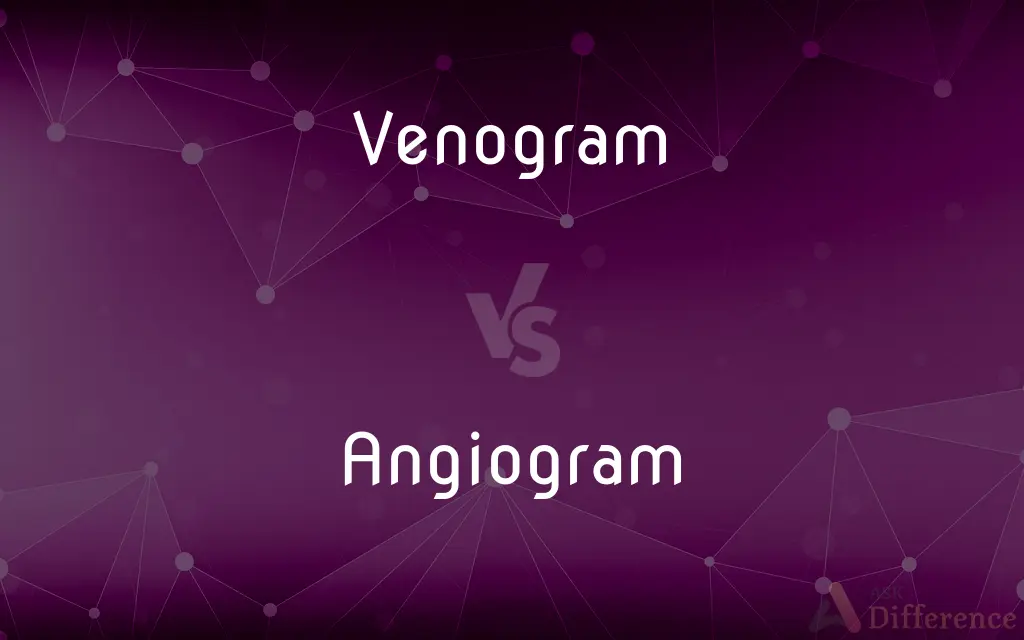Venogram vs. Angiogram — What's the Difference?
By Tayyaba Rehman & Fiza Rafique — Updated on April 7, 2024
Venogram focuses on imaging veins, typically using contrast dye, while angiogram images both veins and arteries, often to identify blockages.

Difference Between Venogram and Angiogram
Table of Contents
ADVERTISEMENT
Key Differences
A venogram is a specific type of medical imaging test designed to visualize veins, especially to detect conditions like deep vein thrombosis (DVT) or other vein abnormalities. It involves the injection of a contrast dye into the venous system, making the veins visible on X-ray images. On the other hand, an angiogram is a broader term for a procedure that images blood vessels, including both veins and arteries. Angiograms are commonly used to identify blockages or abnormalities in the arterial system, such as those leading to heart attacks or strokes, and can involve various imaging techniques including X-ray, CT, or MRI, depending on the area being examined.
While the primary purpose of a venogram is to assess the health and function of the venous system, angiograms serve a wider range of diagnostic purposes, including evaluating the health of both the arterial and venous systems. Angiograms are particularly valuable in cardiology and vascular medicine for diagnosing heart diseases, aneurysms, and peripheral artery disease.
The contrast dye used in venograms makes the veins appear clearly on X-ray images, allowing for the detailed examination of vein structure and function. In contrast, angiograms may use similar contrast dyes but are applied in a way to highlight both arteries and veins, or specifically arteries in cases like coronary angiograms, to detect areas of restriction or to evaluate the vascular system after surgical interventions.
In terms of procedural differences, venograms are typically focused on the legs, pelvis, or other specific areas where vein problems are suspected. Angiograms, however, can be targeted to various parts of the body, including the heart (coronary angiogram), brain (cerebral angiogram), lungs (pulmonary angiogram), and more, reflecting their broader application in diagnosing and managing vascular diseases.
Despite these differences, both venograms and angiograms are critical tools in modern medicine, providing essential information for the diagnosis and treatment of a wide range of vascular conditions. They are often complementary, with the choice between them depending on the specific clinical scenario and the type of vascular issue suspected.
ADVERTISEMENT
Comparison Chart
Focus
Veins
Both veins and arteries
Common Uses
Detecting DVT, vein abnormalities
Identifying blockages, arterial diseases
Contrast Dye
Used to visualize veins
Used for both veins and arteries
Diagnostic Scope
Limited to venous system
Broad, including arterial and venous systems
Typical Procedure Sites
Legs, pelvis
Heart, brain, lungs, peripheral vessels
Compare with Definitions
Venogram
A diagnostic test that uses X-ray imaging and contrast dye to visualize veins.
A venogram is often performed to diagnose deep vein thrombosis in a patient's legs.
Angiogram
A medical imaging test that visualizes the vessels, including arteries and veins, using contrast dye.
An angiogram can be used to identify blockages in the coronary arteries that might lead to a heart attack.
Venogram
Recommended for venous insufficiency, DVT, and varicose veins.
Patients with symptoms of venous insufficiency may undergo a venogram for a definitive diagnosis.
Angiogram
Diagnoses a wide range of vascular conditions, from blockages to malformations.
Angiograms are crucial in planning treatments for patients with arterial blockages.
Venogram
Provides detailed images of the venous system.
Venograms offer clear, detailed views that are crucial for the accurate diagnosis of venous conditions.
Angiogram
Can be performed using X-ray, CT, or MRI, depending on the area being examined.
Coronary angiograms involve catheterization to deliver contrast dye directly into the heart's arteries.
Venogram
Identifies abnormalities or blockages in the venous system.
Venograms can reveal the presence of clots that could lead to serious complications if untreated.
Angiogram
Offers comprehensive information on the health of the vascular system.
Angiograms provide essential data for making informed decisions about interventions like stenting or surgery.
Venogram
Involves injecting a contrast dye into the veins.
During a venogram, contrast dye is carefully injected to ensure veins are clearly visible on the X-ray.
Angiogram
Used for evaluating heart diseases, aneurysms, and peripheral artery disease.
A cerebral angiogram might be ordered to investigate the cause of a stroke.
Venogram
A radiograph of a vein after injection of a radiopaque substance.
Angiogram
Am X-ray photograph produced by angiography.
Venogram
Venography.
Venogram
(medicine) An X-ray of a vein that has been injected with an opaque material
Venogram
An X ray of a vein injected with a radiopaque contrast medium
Common Curiosities
What is the main difference between a venogram and an angiogram?
A venogram focuses on imaging veins, while an angiogram images both veins and arteries.
Can these procedures detect heart conditions?
Yes, angiograms, especially coronary angiograms, are used to detect heart conditions like artery blockages.
Are there any risks associated with venograms or angiograms?
Both procedures carry minor risks related to the contrast dye, such as allergic reactions or kidney strain, and procedural risks like bleeding or infection at the injection site.
Is hospitalization required for these procedures?
These procedures are often done on an outpatient basis, though some cases may require observation or hospitalization.
How long do these tests take?
The duration varies, but most are completed within an hour, not including preparation and recovery time.
Can venograms and angiograms be used for treatments as well?
While primarily diagnostic, these procedures can guide interventions like angioplasty or stent placement.
What happens after the procedure?
Patients are monitored for a short period, and results are usually discussed at a follow-up appointment.
Why is contrast dye used in these procedures?
Contrast dye enhances the visibility of blood vessels on imaging tests, allowing for detailed examination.
What is the recovery time after a venogram or angiogram?
Recovery is usually quick, with most patients resuming normal activities within a day, barring complications.
How do doctors decide which test to use?
The choice depends on the specific vascular issue suspected; venograms for venous conditions, and angiograms for broader vascular evaluation.
What advancements have been made in venogram and angiogram technology?
Advances include higher resolution imaging, reduced contrast dye amounts, and minimally invasive techniques for improved safety and accuracy.
Are there any alternative tests to venograms or angiograms?
Alternatives may include ultrasound or non-contrast MRI, depending on the condition being investigated.
Do these procedures require anesthesia?
Local anesthesia is commonly used, and sedation may be provided for comfort.
How should patients prepare for a venogram or angiogram?
Preparation might include fasting, stopping certain medications, and arranging for post-procedure transportation.
Can venograms and angiograms visualize all blood vessels?
While highly effective, certain small or deeply situated vessels may require specialized imaging techniques.
Share Your Discovery

Previous Comparison
Conservator vs. Executor
Next Comparison
Nominal vs. NotionalAuthor Spotlight
Written by
Tayyaba RehmanTayyaba Rehman is a distinguished writer, currently serving as a primary contributor to askdifference.com. As a researcher in semantics and etymology, Tayyaba's passion for the complexity of languages and their distinctions has found a perfect home on the platform. Tayyaba delves into the intricacies of language, distinguishing between commonly confused words and phrases, thereby providing clarity for readers worldwide.
Co-written by
Fiza RafiqueFiza Rafique is a skilled content writer at AskDifference.com, where she meticulously refines and enhances written pieces. Drawing from her vast editorial expertise, Fiza ensures clarity, accuracy, and precision in every article. Passionate about language, she continually seeks to elevate the quality of content for readers worldwide.















































